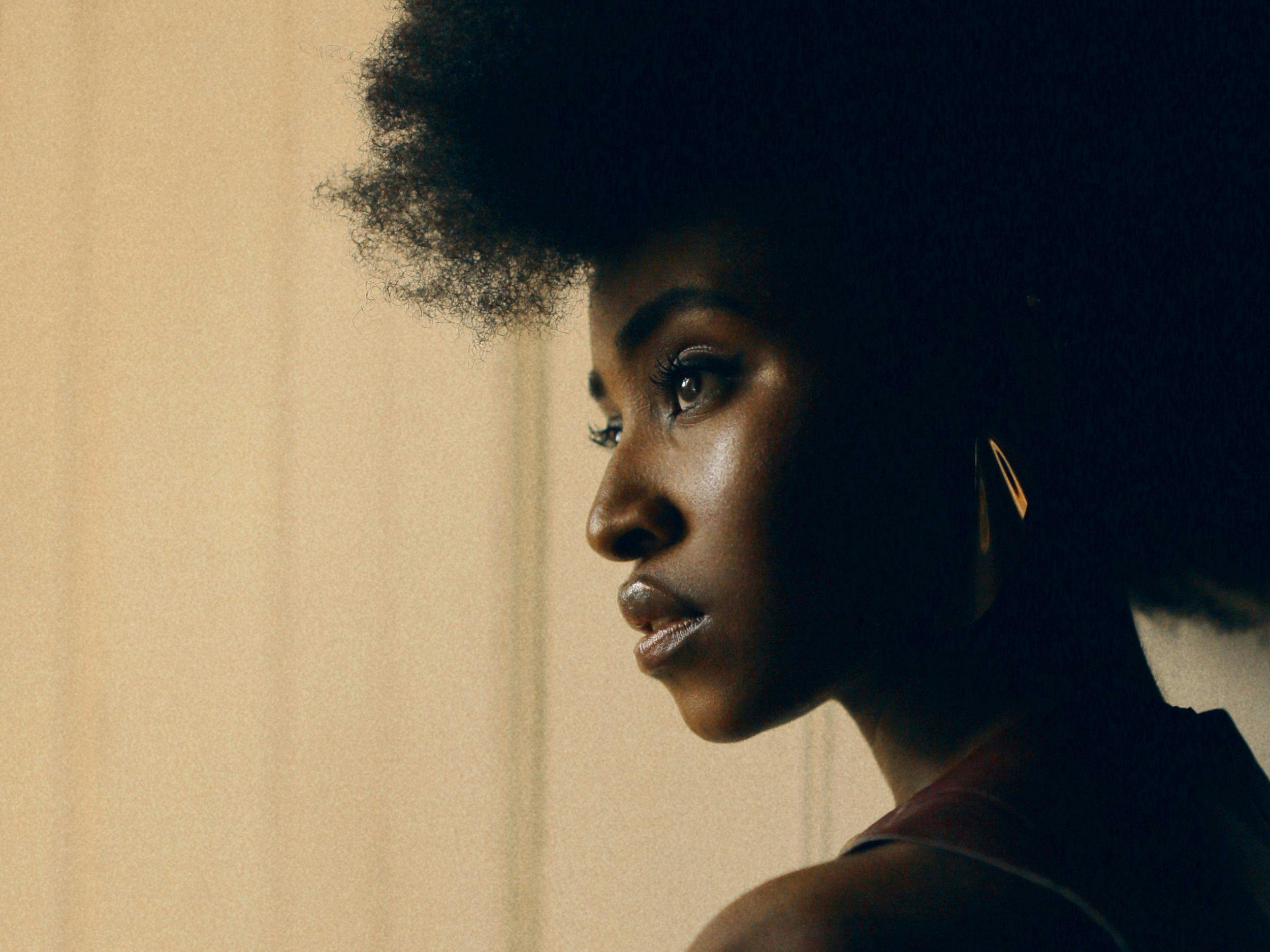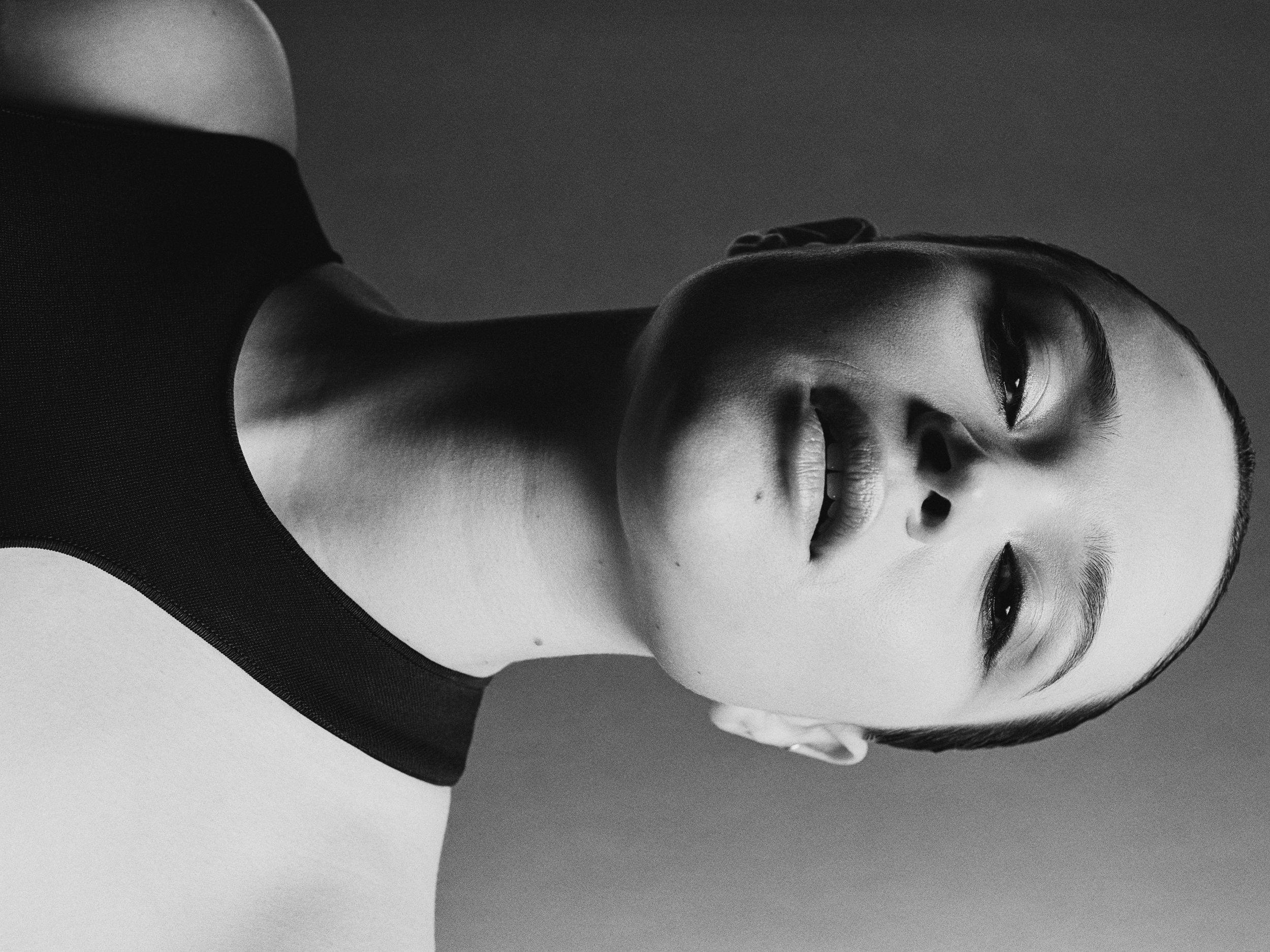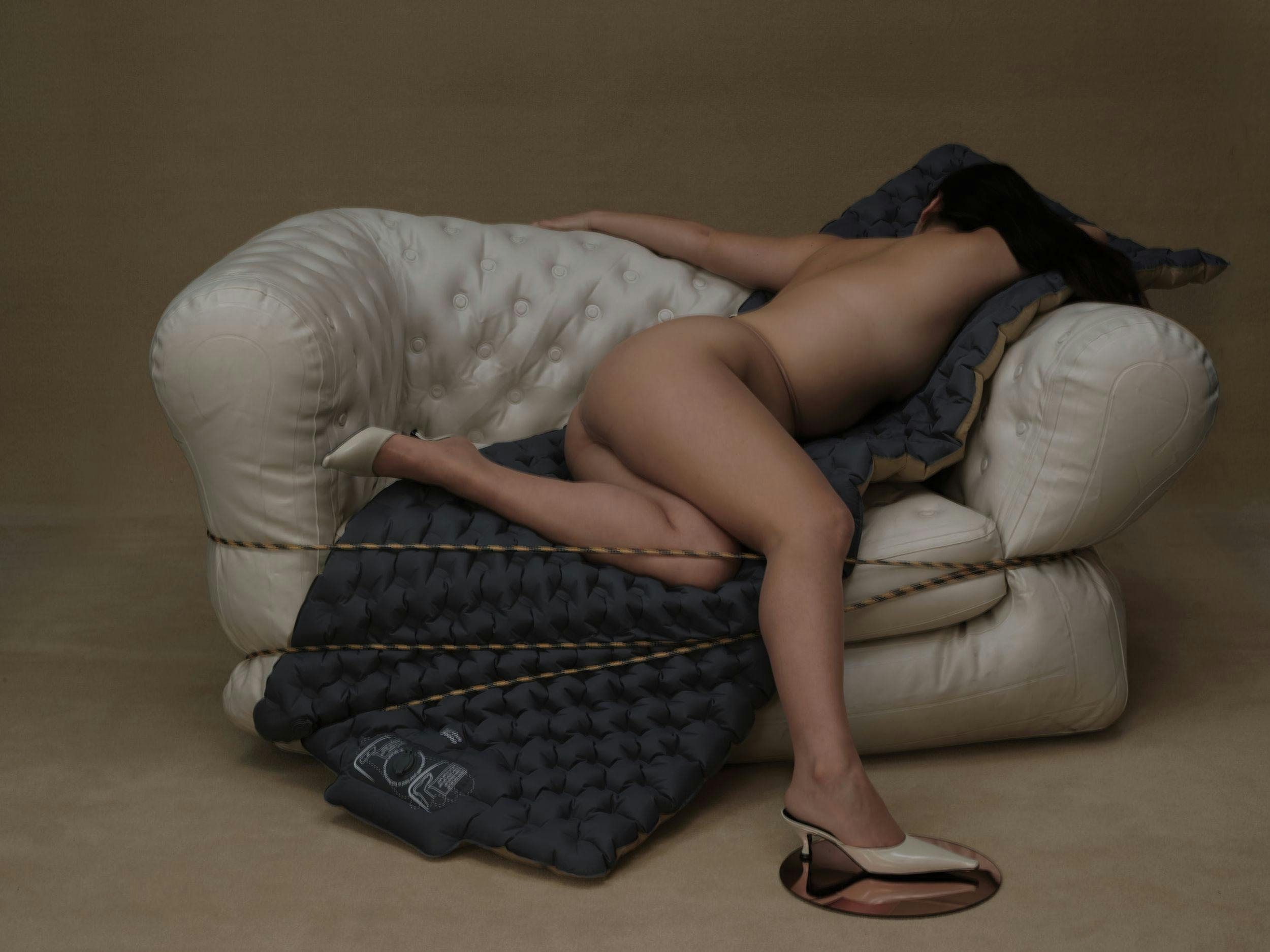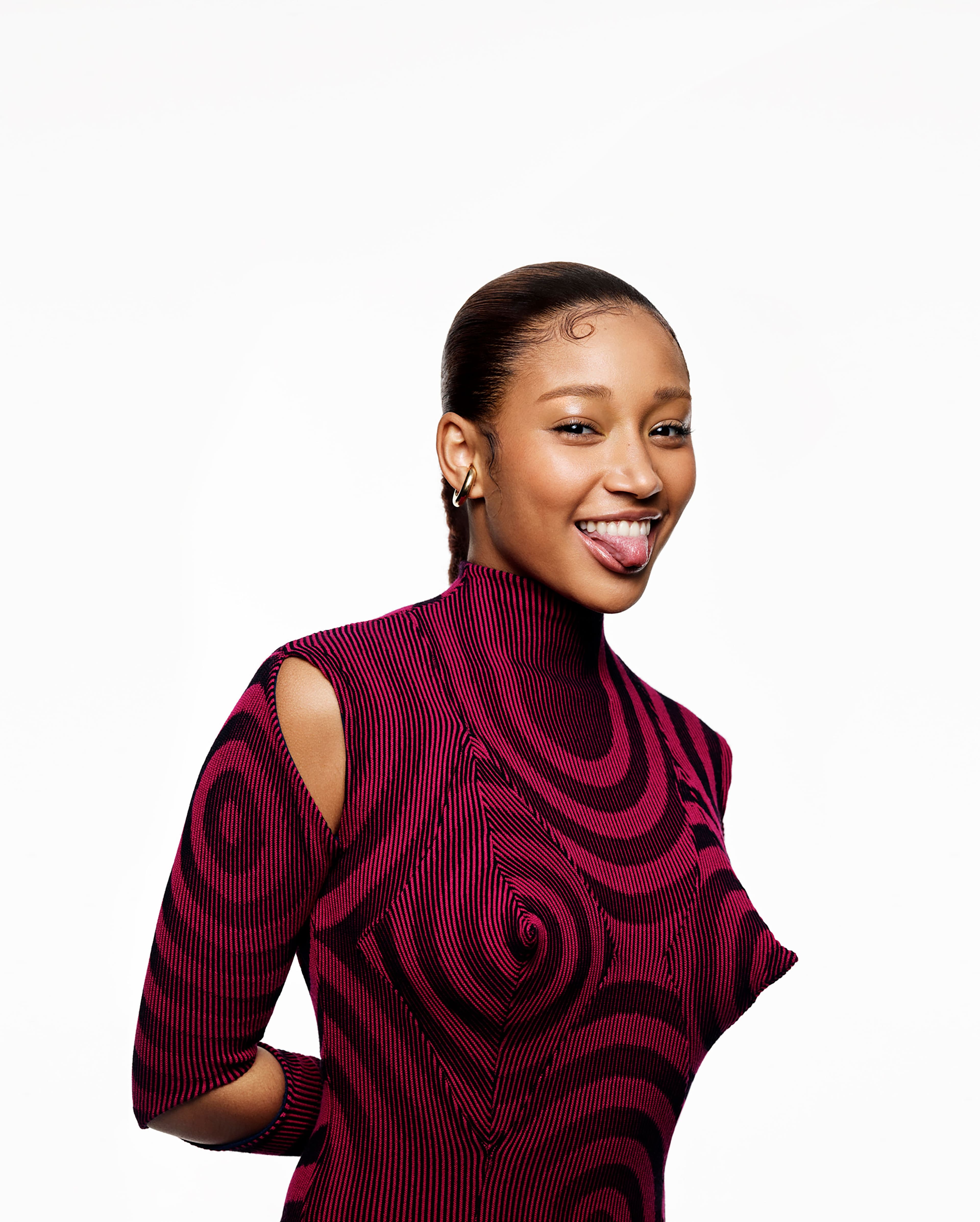
Bodysuit by Paolina Russo. Ear cuff by Jennifer Fisher.
Amandla Stenberg Is Working to Reform Hollywood
On rare occasions, the synergy between an actor and a role is so complete that the two become inextricably linked, bound together in cultural memory thanks to a perfect and timeless combination of talent, circumstance, and luck. Amandla Stenberg has already achieved that harmony once in her decade-long career through her portrayal of Starr Carter, a high school student who undergoes a political and personal awakening after watching her friend get killed by a police officer, in the 2018 film adaptation of Angie Thomas’s acclaimed young adult novel The Hate U Give. The 22-year-old Stenberg has spoken often about the inspiration she took from playing Starr in one of the few mainstream films to touch upon the early Black Lives Matter movement, and the affinity is mutual, as Thomas says the actress—and particularly her school project about cultural appropriation called “Don’t Cash Crop My Cornrows,“ which went viral when she was sixteen and already well-known from her performance as the doomed Rue in The Hunger Games—helped shape her conception of Starr while she was writing.
Stenberg, who will next be seen this September in the film version of the Tony-winning musical Dear Evan Hansen, won an NAACP Image Award for her performance as the conflicted Starr, who lives in a Black community and attends a privileged, predominantly white private school, and has used her platform to speak cogently and vehemently about the systemic inequalities she sees and experiences as a queer Black woman. She is no latecomer to the movement, as so many celebrities were last summer as America at last began to open its eyes to the need for equity and reconciliation, but rather has made her activism an essential part of her being ever since her early teenage years. Now one of Hollywood’s leading young performers, she recognizes the impact of every role she chooses, every interview she sits for, every image she posts to Instagram. She is driven, she says, by the need to push the industry to reform itself by rejecting its long dependence on tokenism, colorism, and the various other forms of racism that course through the foundations of this country.
In an exclusive conversation for Cero Magazine, Stenberg reconnected with Thomas—who in January released Concrete Rose, a prequel to The Hate U Give about Starr’s father Maverick—over Zoom earlier this year for a wide-ranging discussion about representation, grassroots activism, and online feuds. The result is nothing less than, as the author herself calls it, a family reunion. —Jonathan Shia

Vintage jacket by Helmut Lang from the David Casavant Archive. Dress by Loewe. Shoes by Linder x Mephisto. Ear cuff by Jennifer Fisher.
Angie Thomas I was honored when they asked me to do this because you know how much I adore you. Just the opportunity to talk to you and hopefully help introduce more people to you—first of all, if they don’t know you already, they need to get out from under whatever rock they’ve been living under, but you are brilliance personified, so it’s an honor to do this. When I think about you, I think about how I first got introduced to you. I first saw you obviously in Colombiana, and I was like, “That is a little bad-ass kid!“ [Laughs]
Amandla Stenberg That was inexplicably a movie that Black people love so much. [Laughs] That one in particular.
AT Yes! I was like, “That is a little bad-ass kid!“ Then I remember I saw your video “Don’t Cash Crop My Cornrows,“ and I was absolutely blown away. I was just in awe of you and the brilliance that you showed in that. Knowing how young you were, I was like, “The rest of us got some work to do.“ At that time, I was working on The Hate U Give, and I kept seeing you pop in my head whenever I was writing that character. If nothing else, I don’t know if you will ever realize how much you inspired me by doing that and helped me recognize the power of art and media to engage people. If you’d like to talk a little bit about how you came to do that, and did you recognize even then the power of art and media to engage people?
AS I haven’t been asked this in a long time. I think at the time I was lucky to have the internet. I was at a really crucial point in my self-development where I was having the traditional classic moment of unlearning my internalized self-hatred and reclaiming my identity and my Blackness. A lot of that, which you’re aware of, was a process I had to go through because I attended a private school with probably eighty to ninety percent white people, and I was one of the four girls of color in my grade. So around the age of sixteen, because I had access to Tumblr and the internet and was able to witness and take part in the conversations on those platforms, I arrived at a point where the most obvious and natural thing seemed to be to unlearn all the internalized bias and try to make some radical change within myself around how I conceptualized myself and how I loved myself. I think really, at that point in time, it was just a personal journey, and it was just a personal journey that went viral by accident. [Laughs] I was in a class at the time with a really cool teacher named Deb called MUSH, Modern US History, and one of the assignments was for us to document the history of an artifact over the course of ten years. At the time, I was really close with one of my classmates, Quinn Masterson, and she actually came up with the idea of talking to each other about appropriation and having conversations about what was going on, what was being discussed in these virtual spaces. She had the idea to document cornrows over the course of ten years because we were so fascinated by, how is this shifting right now? The conversation was just starting to open up, particularly on Tumblr, and at that moment, I couldn’t stop thinking about it. We got into the research process together, we worked on it for probably a couple of weeks. We came up with the script and then I just ended up recording it on my bed in my bedroom and showed it to my class. It was kind of medium to lukewarm responses.
AT I was just about to ask, how did they respond to it?
AS At the same time, I was showing it to a primarily white group of people and the conversation was a newer conversation at that point. I had learned it through the internet, through being on Twitter or Tumblr, and Tumblr at that point in time was such a hyper-radical space and a very important space. I feel like at this moment, it’s kind of fallen off a bit in terms of how it’s centered in conversation, but at that moment, all these brand-new, exciting conversations were happening on there in a way that I’d never seen before. So I got the lukewarm responses in the Modern US History class, and Quinn and I decided to post it on Tumblr because we knew that would be the space that would be most apt for it. Nothing really happened. A few people saw it here and there, and then several months later, I got into an online feud with Kylie Jenner. [Laughs]
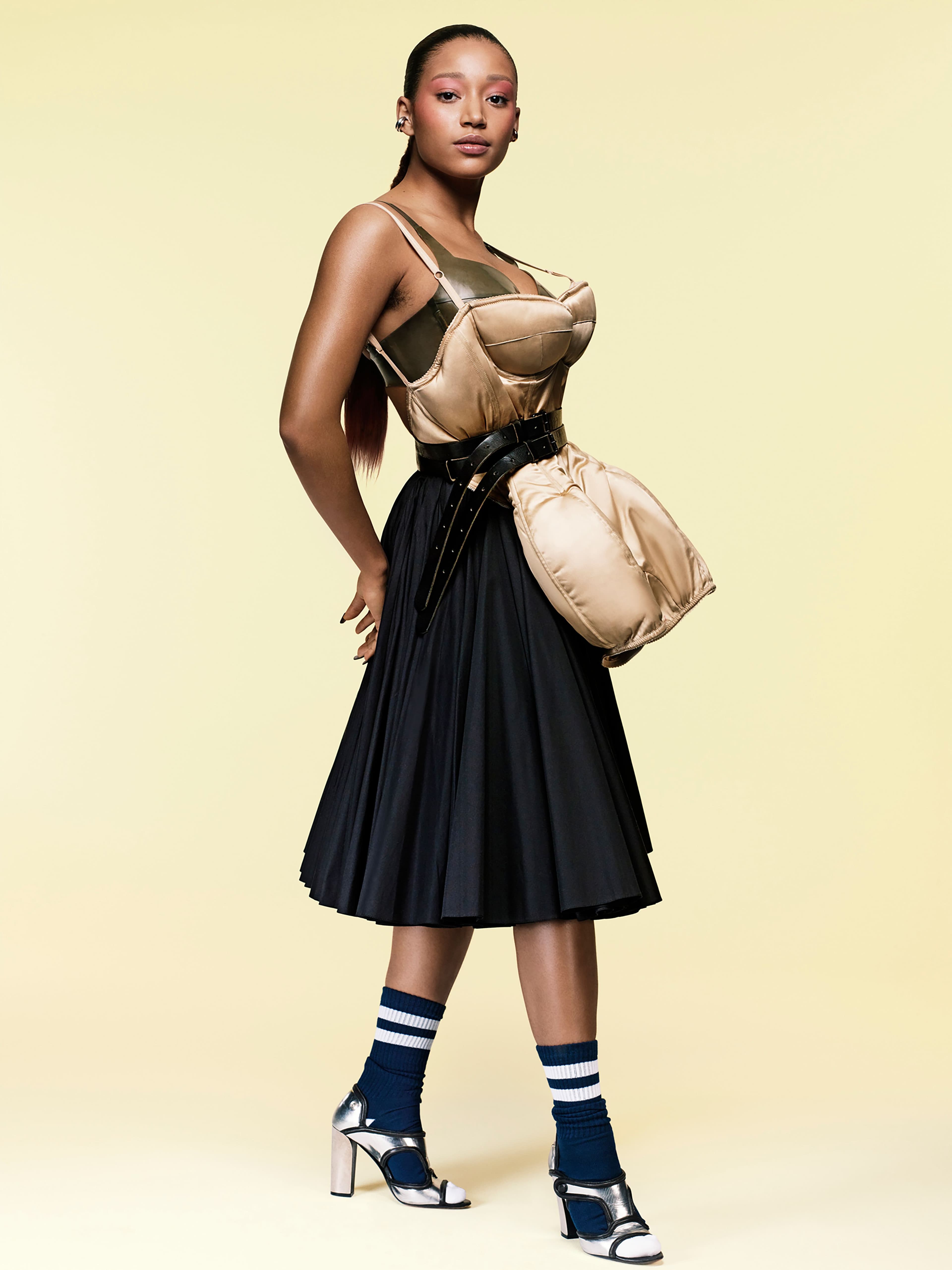
Vintage bodysuit from the Albright Fashion Library. Bra by Atsuko Kudo. Skirt by Emilia Wickstead. Socks by Converse. Vintage shoes by Pierre Hardy from the Albright Fashion Library. Vintage belt by Raf Simons from the David Casavant Archive. Ear cuffs on right ear by, from top, All Blues and Jennifer Fisher. Ear cuff on left ear by Jennifer Fisher.
AT [Laughs] Oh yeah, I forgot about that!
AS And that is actually what caused the video to go viral. I was acting up, to be quite honest. My friend and I would comment on posts a lot or send posts to each other a lot, and she tagged me in a post of Kylie Jenner wearing cornrows and I just responded to her, just got on those keys and rat tat tat tat tat. I didn’t even think about the fact that people paid attention to my account, that I was a child actor—none of these things crossed my mind. But I fired off this snarky response. [Laughs] It was like, “Isn’t it funny when people appropriate Black culture and fail to recognize that they’re profiting off Blackness because they’re directing all their advertisements towards selling their wigs, but not shedding new light on police brutality or issues that affect Black people?“
AT You went there! [Laughs]
AS [Laughs] I really went there! And then I said, “#whitegirlsdoitbetter.“ [Facepalm] This is just something I would have said to my friend in private, but unfortunately, it was on a public forum, so it immediately went viral. People started really looking at it, and she did respond. I won’t get into that, but she did respond. Then I think because this conversation on cultural appropriation was centered in this very mainstream way around someone like Kylie Jenner, people started paying more attention to my Tumblr and things that were on there. They found the video from my class, and they started reblogging it like wildfire. And that was how “Don’t Cash Crop My Cornrows“ went viral. [Laughs]
AT [Laughs] That’s amazing. I remember reading about you leaving that comment and I was like, “Oh snap!“
AS My mom was so upset. I remember it was the summertime, I was staying at my aunt’s house in the Bronx, and I was supposed to be working on a chemistry paper. Instead, I was just procrastinating and commenting on Instagram, and this is when it went viral. It went viral pretty quickly. My aunt lives in a brownstone, and I was on the top floor of the brownstone, and I remember my mom rushing up the stairs, hearing her feet go up the stairs and her open the door and go, “Amandla, what are you doing on there!“ [Laughs]
AT [Laughs] Oh no!
AS She was like, “You’re supposed to be working on your chemistry paper! And you’re getting into online public feuds.“
AT But I’m sure you know the thing about parents is they will get on you about how you do things, but I bet she agreed with every word you said.
AS Yeah, that’s true. It was more about the fact that I really had been procrastinating on that chemistry paper. [Laughs]
AT [Laughs] You’re like, “I’m out here trying to change people’s perspectives, and you’re on me about a chemistry paper? Seriously?“
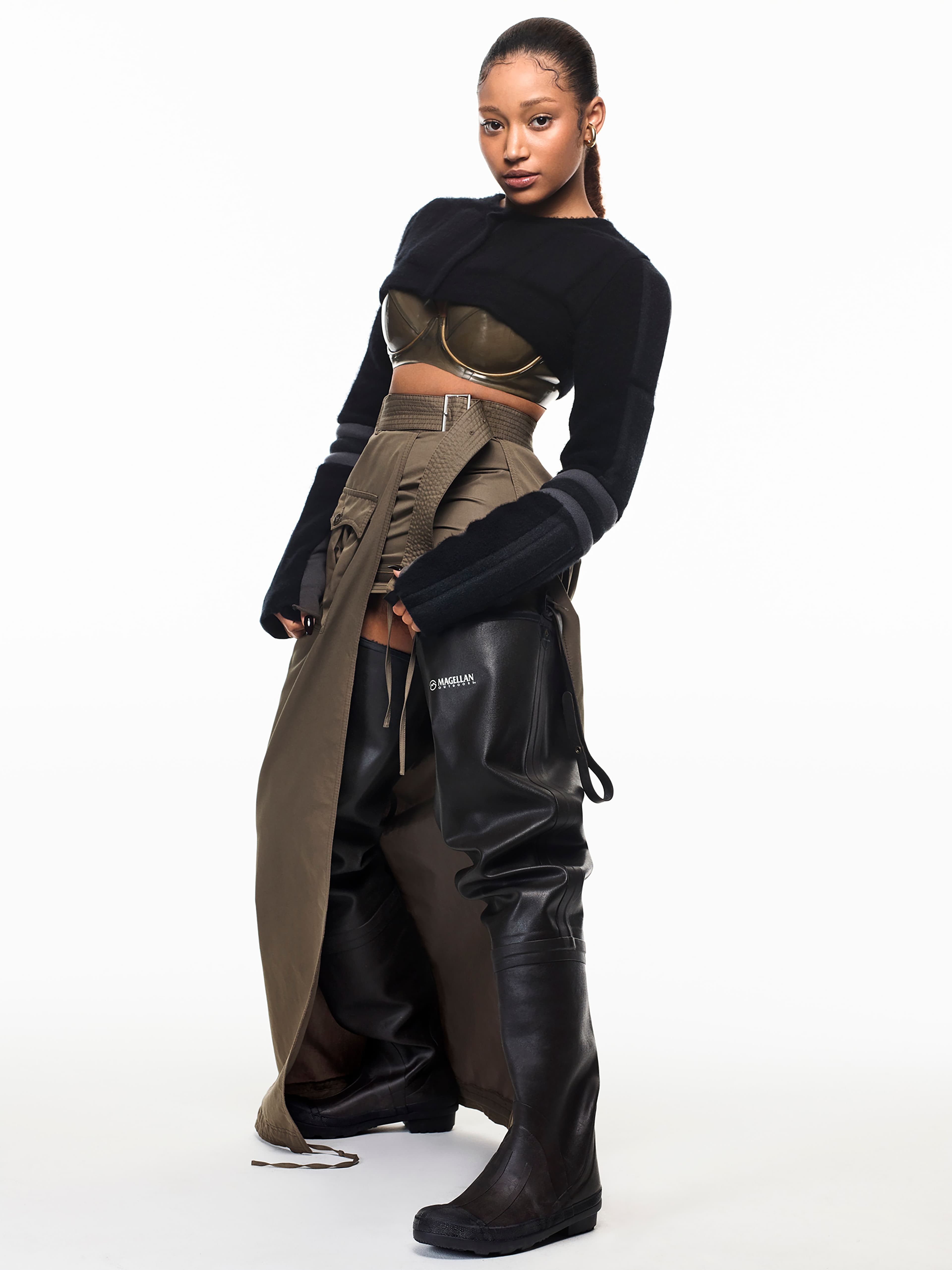
Vintage top by Helmut Lang from the David Casavant Archive. Bra by Atsuko Kudo. Vintage skirt by Jean Paul Gaultier from the Albright Fashion Library. Boots by Magellan. Ear cuff by All Blues.
AS What was really cool about my high school education is that my teachers were really flexible and allowed me to explore the topics that I wanted to explore. I think around the time the online feud with Kylie happened, she tried to come for me on a personal level—I guess I did come for her on a personal level as well. [Laughs] But she made it less about cultural appropriation and the topic that I was actually trying to address, so I ended up posting a statement about it, and the statement actually came from an essay that I was writing at that moment for my humanities class. It’s funny looking back at how much of what I was sharing at that point was just what I was working on in high school.
AT It goes to show, if nothing else, you had some good teachers. I think that there’s something to that, the fact that you were becoming more aware and taking in all this information, and you were making yourself heard and causing conversations. That’s power! That is power! Growing up in Hollywood in an industry that is so superficial, that avoids conversations like that, I can see how you could’ve almost felt intimidated to say anything. I’m glad that it didn’t even cross your mind because we ended up with a cultural moment as a result of that. Since you grew up in the industry in a lot of ways, how has that experience influenced the roles you choose, and what draws you to certain projects? What do you hope to do in the future?
AS First, I want to say that I felt really, really lucky at that moment, and now as well, to have been validated and inspired by my peers because when that cultural moment happened, it was inspired by so much of the conversation that was already happening in the very radical and smart spirit and ethos of a community of teenagers online. I was lucky to have the built-in platform already to continue the conversation and also just a passion for academia, basically. [Laughs] I think the combination of those elements led to that fortuitous moment, but I think that conversation was brewing already a lot, and I was lucky to learn about it.
When it comes to roles, I think the answer to that question for me shifts a bit. Whenever I play a role, I’m definitely very conscious of the responsibility that I hold in terms of representing a Black experience. Or in the future, a queer experience, which I’m very excited about. As things shift within the industry and shift in terms of representation, I also think my place and responsibility shift. I think several years ago, there was this mass calling for representation of Blackness and it began happening. It actually began being heeded in a way that was so exhilarating. I think the studios and the industry have had to reconcile with there being power in the hands of their audience because they’re able to collectively organize online and decide where they’re putting their money and their time. That’s been a really exciting shift to witness, especially having grown up a child actor. It feels like leaps and bounds in terms of representation that I see for Black girls in my inbox, even on a daily basis. The characterization of those Black girls and their depth and what they have to say, it feels so different than what I remember picking through as a kid and feeling really disappointed and canonized by. I think at this point in time, I always feel like if I can read a script and my heart starts to just ache and burn a little bit, but in a good way, then I’m probably reading something that would feel powerful to align myself with. I just care about depicting Black girls’ experiences with nuance, with clarity, with love, and I also at this point almost think we’re getting past the point of tolerating representation that is not inclusive within the Black community. There is so much work to be done. Of course, whenever I choose a role, I’m trying to think critically about its significance in terms of representation and what it contributes to narratives around Black people. Or I’m just curious to explore a facet of someone’s experience that maybe I feel hasn’t been able to be traditionally told. We are starting to be critical of the fact that Hollywood, being a white institution, extends that racism through colorism in the casting of Black people. So while I feel joy and love being able to represent a facet or a particular sliver of Blackness, at the same time I’m so glad that these conversations are starting to open up because colorism is such an insidious arm and extension of that racism within Hollywood. The conversation around representation needs to progress in order to include conversations around colorism and needs to accurately reflect the beautiful wide variety of experiences and shades. So when it comes to conversations around representation, I almost feel like hopefully, the conversation is progressing past that point.
AT Since you are very deliberate in the roles you choose, what was it about Starr that drew you in, and what was it that you learned from playing that character? I have a book behind me with you on it. I don’t know if that’s creepy or not. [Laughs]
AS [Laughs] Oh my goodness. What didn’t attract me towards Starr and The Hate U Give? I immediately fell in love with it the second that my eyes hit the page. The first time I read the book, I actually read it on my iPhone. I was about to go to bed, the manuscript came through my inbox, and I was just scrolling on my phone and I started reading. Once I started reading, I could not stop. I had meant to just take a little glance at it, but it was impossible once I began because the story that you created is just so powerful, so beautiful. It’s just love incarnate. It’s joy incarnate. It’s anger, it’s critical learning, it’s growth. It’s so beautiful and meaningful to me and will be such a massive part of my heart forever. We’ve talked about this a lot, but when I first read the book, I felt like there were some eerie parallels between Starr’s experience and my own experience growing up, particularly growing up in a Black community and then going to a private school across town with primarily white students. That was an experience that I immediately was able to cling to and relate to. With the representation of code-switching in the characterization of Starr, she’s such a vibrant, loveable character, and I immediately looked up to her so much. She embodied so many of the things that I wanted to be or wanted to strive towards and her courage and her journey of growth in terms of learning how to use her voice despite the variables at play, which are terrifying and scary. She learns how to just undeniably share her voice and shine her light. Initially falling in love with The Hate U Give was falling in love with the book but also falling in love with Starr, seeing her as a role model. Oftentimes even when working on the movie, I felt like Starr was my older sister or a girl in my high school class that I looked up to or a girl that I would follow on the internet. I see lots of elements of her that I relate to, but so much of my journey with her and in playing her was a journey of learning about her, looking up to her, learning from her. The things that I learned were so invaluable, and it’s because you infused them into her, Angie, because you embody them too. I learned resilience. I learned bravery. I learned not to care what other people think about you when it’s not necessary. I just have to commend you for your unwavering commitment to the love in the story because that’s what’s most powerful about it and why so many people have connected to it and adored it. That love permeated the set undeniably because, with your text in our hands, we knew that we could not show up with any other intention besides channeling that love and giving it a space and allowing it to shine for itself. You know I love you.
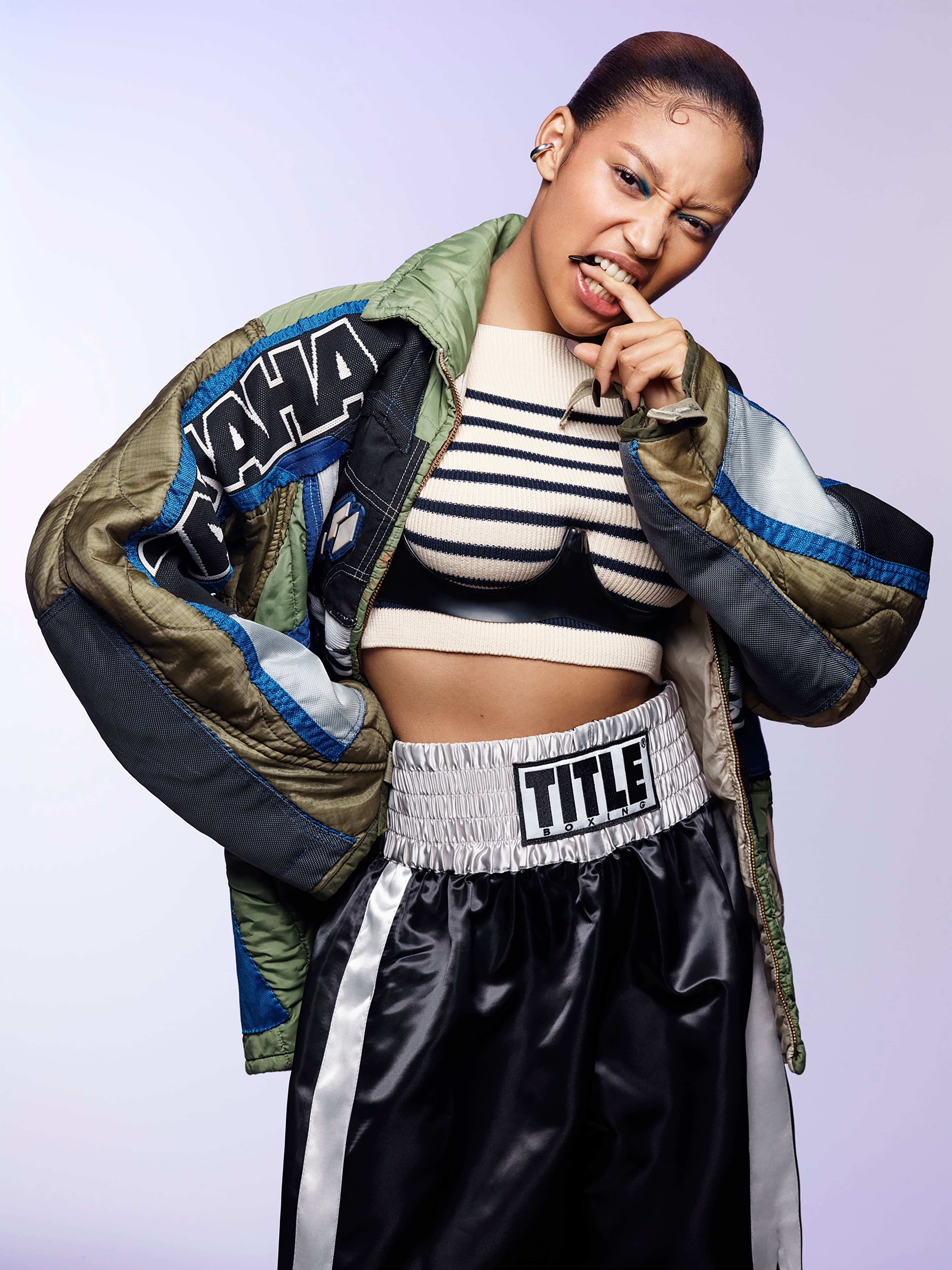
Jacket by Courtney MC. Bra by Atusko Kudo. Vintage top by Jean Paul Gaultier from the Albright Fashion Library. Vintage shorts by Title Boxing from the David Casavant Archive. Ear cuff by All Blues.
AT You know I love you! The love that you put into that role was the best gift anybody’s ever given me. I’m not going to cry. I’m so, so, so appreciative, and I saw what you went through to bring that character to life. I remember even when y’all had to film again because of the whole recast stuff [Editor’s note: Kian Lawley, who originally played Starr’s boyfriend in the film, was replaced by KJ Apa after video surfaced of the former using racial slurs.] and the emotional burden you had to carry in just doing that, with the ironic thing being because it was a white guy being racist that led to all of that bullshit. Just knowing that you had to go through that again and seeing how it affected you emotionally, even with filming the shooting scenes and all of that, I don’t think I can ever thank you enough for taking that on. I can’t, because to this day, I’ve had so many people tell me how much you and that movie affected them, changed them. I’ve had kids of white supremacists reach out to me, and they say that they watched the movie before they read the book and how Starr affected them in such a way that they started questioning everything their parents ever put in their heads. That shows the power that you brought through that, the power that you have. Again I can never thank you enough for it. You truly gave us all a gift in that, and I think you also gave the movement a gift because we see now that more people are having these conversations. We’re seeing more people are trying to understand what we even mean when we say Black Lives Matter. We’re seeing discussions of it, and this past summer seeing a boiling point, although I fear that it’s just going to take another boiling point for something to actually change. With everything that’s happened this past year with the movement specifically, what do you think the good and the bad was about its newfound prominence, and where do you hope these discussions lead in the future?
AS This past summer, with the prominence of Black Lives Matter and all of the actions and protests, I found myself often researching abolition because there were new approaches that were being spearheaded in the movement. I honestly was one of those people who didn’t fully understand the concept of defunding the police when it first was proposed. I had to do some research and understand more about the prison industrial complex, understand more about the history of abolition, of what it means to deconstruct a police state in order to fully grasp the concept and understand what we were marching for and how this is another extension of work that has been being done for so many years. That’s been really exciting to me, the fact that we are able to lean into these new positions and that we’re able to take more radical approaches to introduce more radical ideas. I feel so lucky to know Patrice Cullors because she’s been so patient in educating and guiding folks into understanding what abolition work looks like and how stages of radical movements work. It makes me think about what it was like when she first introduced the concept of Black Lives Matter in 2014. It was a concept that, at the time, felt really radical to people, which is an indication of where we were at sociopolitically. The fact that saying that a group of people’s lives are important or matter was a radical statement, if anything, reflects the structure of our society back at us. It was wild to hear her say that she had so much of a struggle initially getting people to even understand that concept, and she expressed that she felt similarly at this moment with introducing the concept of defunding the police. But it’s still so exhilarating to now see the movement heading into territory where we’re discussing real structural change, redistribution of resources, prioritization of life, and addressing the issues that manifest in our communities at the source. I think that is so incredible, and I’m so glad that the movement is taking precedence again, and hopefully, it continues to. It’s inevitable that we end up on this news cycle, and sometimes it comes to a head, and the bubble bursts, and then it fades, but I imagine that this conversation will maintain its precedence for the rest of our lives, even if it’s somewhat intermittently. It reminds me of when we were actually filming the movie, and we had to do that round of reshoots. I remember there being this external pressure from the studio or just this anxiety within everyone working on it that if we delayed production any more or if the movie took too much time to make, then the subject matter would be less relevant or less potent, or people would be less open to it. I remember thinking that that was kind of funny because I knew you knew that this issue is not a passing topic. It’s years and decades of radical work, decades of movements, and it’s going to be decades more of work, of critical, necessary work, in order for us to restructure our society and deconstruct the prison state.
AT It’s interesting that people almost act like it’s a trend, and I’m like, “Ha, really.“ No, this is not a trend. This is an ongoing issue. This is in the very fabric of America, the fiber of the fabric of America, and until the fabric is changed, we’re still going to have these issues. You’re just trying to rinse stains out of the carpet that are still going to be there. It’s fascinating. I remember that conversation too. I remember that. I remember several things that the studio was scared about, like that whole scene at the end where Starr throws back the tear gas. At first, they weren’t going to do it, and I had to push back on it. They were afraid that it was too radical. I’m like, “Do you not understand the movie that you’re making, the subject matter?“ Black liberation in any form is going to be radical, is going to be controversial, because white supremacy is just as American as apple pie. When are y’all going to realize that? What’s funny to me is they thought that, and here we are. The book’s been out about four years, the movie’s been about three too now, and people are still talking about it. Jill Biden was doing a conference the other day, and she said she just got The Hate U Give. My biggest desire for that book is that it becomes irrelevant, that Black kids pick it up, and they’re like, “This happened to Black people? Somebody had to code-switch? Police shot Black people?“ That’s my biggest desire. I remember that fear and that “Oh, we got to do it before this trend goes away.“ I’m going to stop talking about that because this is going to print. [Laughs] Let’s go a little lighter. So you are playing Alana in Dear Evan Hansen. I have to tell you one of my best friends is just flipping out about that.
AS You have friends who are in the musical theater community, huh? I can see that. [Laughs]
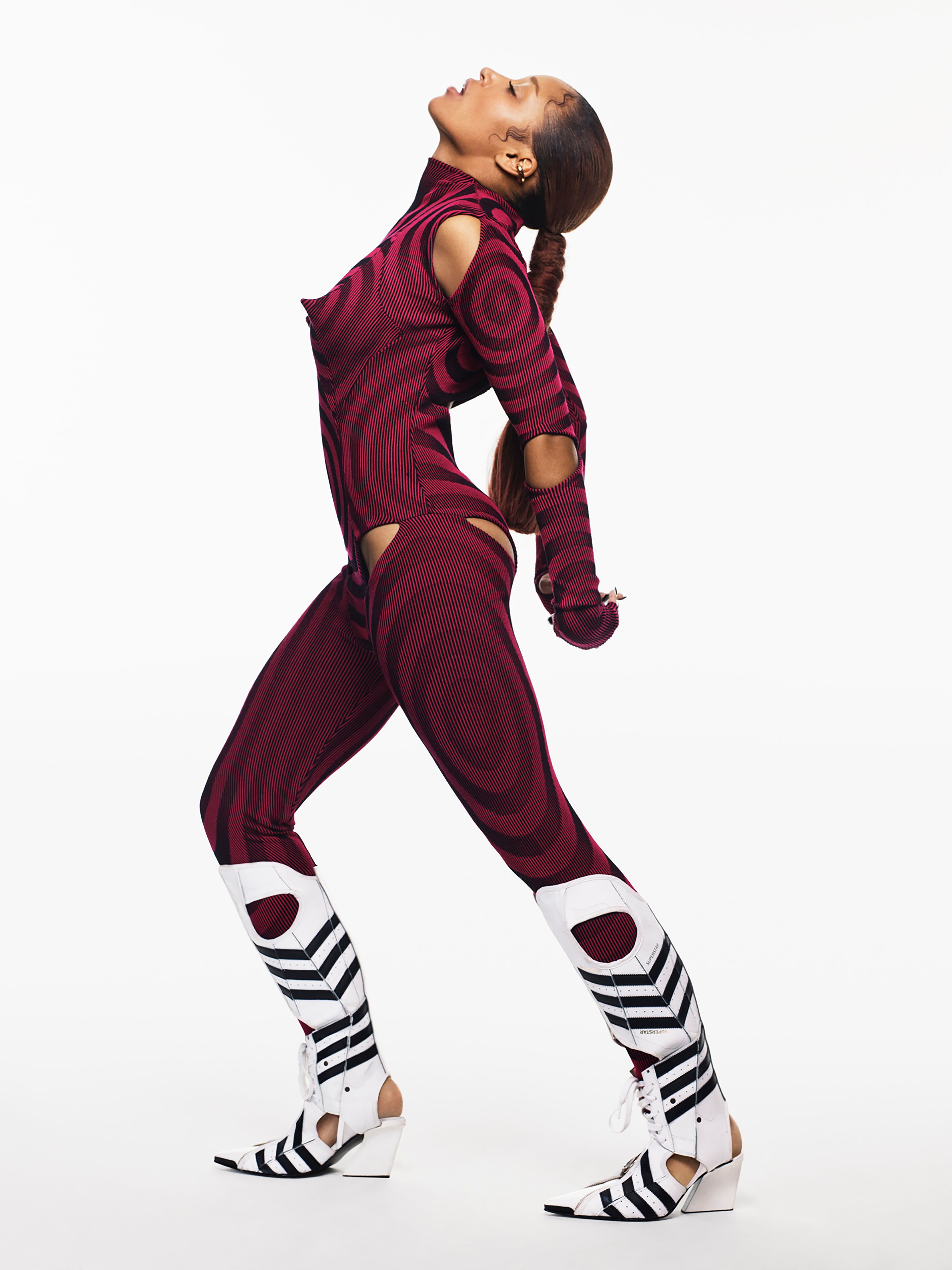
Bodysuit by Paolina Russo. Boots by Paolina Russo x Adidas x Marko Baković. Ear cuff by Jennifer Fisher.
AT Yes, so they’re just so excited about that film. How did that role affect you as far as bringing your musical background to the performance? What was that like?
AS Before I read the script, I’d never seen Dear Evan Hansen on the stage, unfortunately. I’m hoping that one day I can because it feels like the least I can possibly do as a member of the cast of the film adaptation. But I had heard a lot about it, and I had heard that it was really powerful and moving for people, and when I got the logline in my inbox, I was like, “Okay, wait, a musical about teenage suicide. How is this going to work?“ By the end of the script, I was literally crying onto my computer. There were teardrops on my keyboard. I’m very excited to be a part of it. I’m very honored and humbled to be a part of it. I was also, when I began working on it, very terrified to be working on it because I have a very deep passion for music. I love to make music myself, but most of that music I never share, and what was such a gift about Dear Evan Hansen is the songwriters decided to approach me about writing a song for the character to sing. So we wrote a song together, and that’s Alana’s main musical moment in the story. It was an incredible process. It was so much fun. Even just being able to shape the character’s perspective through music was such a cool experience and also was a really exciting way for me to get closer to the character, to understand the character more, and develop her perspective emotionally and just get really immersed into it. It was very scary. I didn’t really know how musicals worked, but the intention with Dear Evan Hansen is to have most of the audio be live, and so we were singing live on set. I love to sing, but I am by no means Broadway trained. I had the pleasure of working with such an impressive cast of Broadway-trained theater actors, but I really had to get over myself. I really had to work hard, and I had to get over myself. I had to have no fear walking through a room of people with my earwig in singing fully a cappella while acting out the scene. [Laughs] That was very challenging. Actually, probably the funniest moment for me, where I was like, “Lord, why?“ was when we were shooting my scene. I don’t want to give too much away. I also don’t know how much I’m allowed to give away, but obviously, the different songs happen in different rooms for different scenes. Mine was choreographed to take place in the high school gym full of students, the bleachers just full of students, and so that was the space where I was singing a cappella for the first time. At one point, sound wanted a very particular kind of recording in the space that required my voice to bounce off of everybody’s bodies because that’s theoretically where I would be in the scene, moving through everyone’s bodies. So what they did is they had all of our extras, there were probably a hundred and fifty of them, and they had all of them circle up, creating a very big circle. Then they had me stand directly in the middle of the circle. They asked for complete quiet on set, and then they had me perform the song a cappella. [Laughs] I was shitting my pants. I was actually shitting my pants. But everyone was really kind, really encouraging. Some of the kids there had seen The Hate U Give or read The Hate U Give and really connected with Starr and so they felt connected to me, and so I felt very accepted in that space. All of our extras were amazing, and a lot of them were really big fans of the musical too, so they were all people who really connected to the story, which is a story about feelings of isolation, particularly in adolescence, wanting, trying, struggling to figure out how to be yourself and how to be your most authentic self and how to connect with other people. That’s the primary storyline and theme of the story. All of the kids were really unique, awesome kids who needed this story and loved this story and felt less alone because of the story. It made for a really beautiful environment. I hope that I can experience that feeling as often as possible the way that I was privileged enough to experience it with The Hate U Give, of just feeling meaning, understanding the kids who connect to the story and need it. It’s such a gratifying movie experience, as you definitely know well enough.
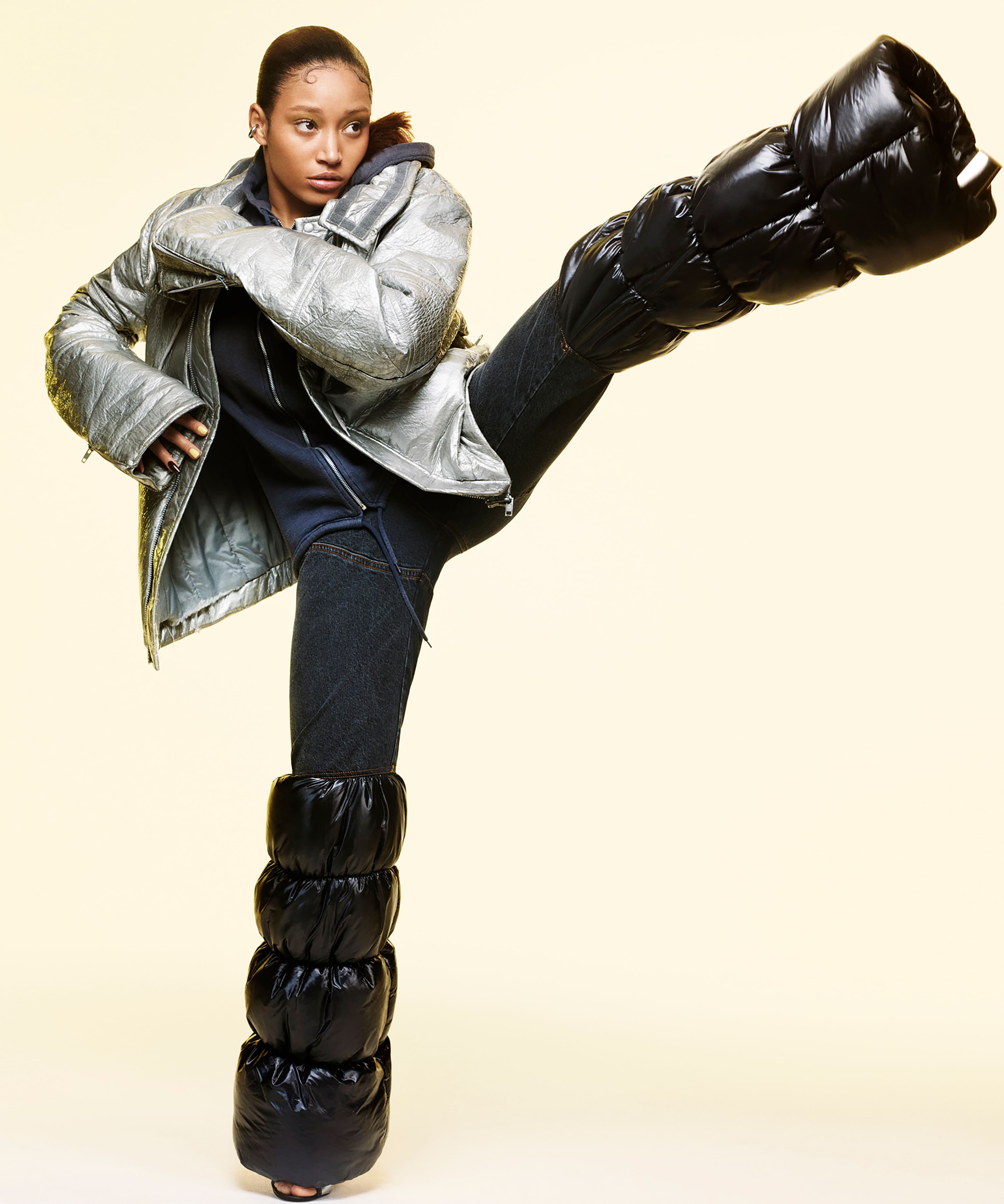
Vintage jacket by Helmut Lang from the David Casavant Archive. Jeans by Telfar. Vintage shoes by Pierre Hardy from the Albright Fashion Library. Ear cuff by Jennifer Fisher.
AT I’m thankful that I write for young people. They’re the best audience to write for, and they’re the best reactors, so I hear you one thousand percent. I’m now working on a project for younger readers, and I’m like, “Okay, this is going to be fun.“
AS Ooh! What age?
AT Well, the main character is twelve. The code name for it right now is “Literal Black Girl Magic“ because it’s a fantasy book. As somebody who loved Harry Potter growing up and was very disappointed when Hermione was white, I’m writing a story that hopefully the little Black girls who want to see themselves as the heroes of the story like that get to have, so I’m excited.
AS That’s so cool! Hermione is Black in my book.
AT When I walked into the movie theater as a kid, I was like, “Who is this white girl?“ Because I was convinced that she was Black. That’s a whole ’nother story for another day. I’ll go to the last question because we’ve kept you long enough, even though this has been fun. With this new generation of young people using their voices, gravitating towards art that speaks to them, that encourages them, that activates them, they’re doing the work, they’re making themselves heard, they’re changing the world one small change at a time. How do you think the activation of young people has evolved over the past couple of years, and what’s your hope for your generation and even the generation behind you for the future?
AS I think what’s really exciting to me, and I notice this within my own community, is that there’s this shift towards implementing the concepts that we talk about in virtual spaces in a real way. I’m really lucky to have an amazing community and network of queer people of color around me, and I learned so much from my community. It’s important to have these conversations within virtual spaces or online and discuss what we want to visualize and manifest for ourselves and learn about how we have to treat each other, the steps that we have to take in order to combat systemic racism or patriarchy. But even more powerful, I think, is learning from my community how to implement those ideas in real time, whether that’s through restorative justice or thinking critically about my interpersonal interactions with people or whether that’s building different networks within the community that people can rely on depending on need. My community acts really radically in that way, and it’s amazing to see what happens when people have formed a network of support when it becomes our inherent nature to organize around whoever is in need, whoever is in the most precarious position, whoever is systemically combating the most. I think my greatest hope is that that work just becomes our inherent responsibility and becomes the way that we move naturally through the world because there’s not going to be any larger change that does not first start in our own communities and within the people closest to us. I think my greatest hope is that we live in a world where people are given all the love they are deserving of, and because we live in a world where that is very much not the case, that means that we have to give extra love to certain people. We got to give them extra resources, we got to make them feel extra supported and extra considered, and we need to make extra, extra room for them. My hope is that we continue learning how to do that interpersonally and that we create spaces within our own communities that can permeate on a larger scale where people are given some equity.
AT You’re amazing.
AS You’re amazing!
AT [Laughs] We can go back and forth on this all day.
AS Angie, thank you so, so much for taking the time out to do this. I so appreciate you and I just love you so much.
AT Aw, no problem. Look, this was my pleasure. It was like a little family reunion.
Read this story and many more in print by ordering our inaugural issue here, with all net proceeds from Stenberg’s cover going to Gays and Lesbians Living in a Transgender Society.
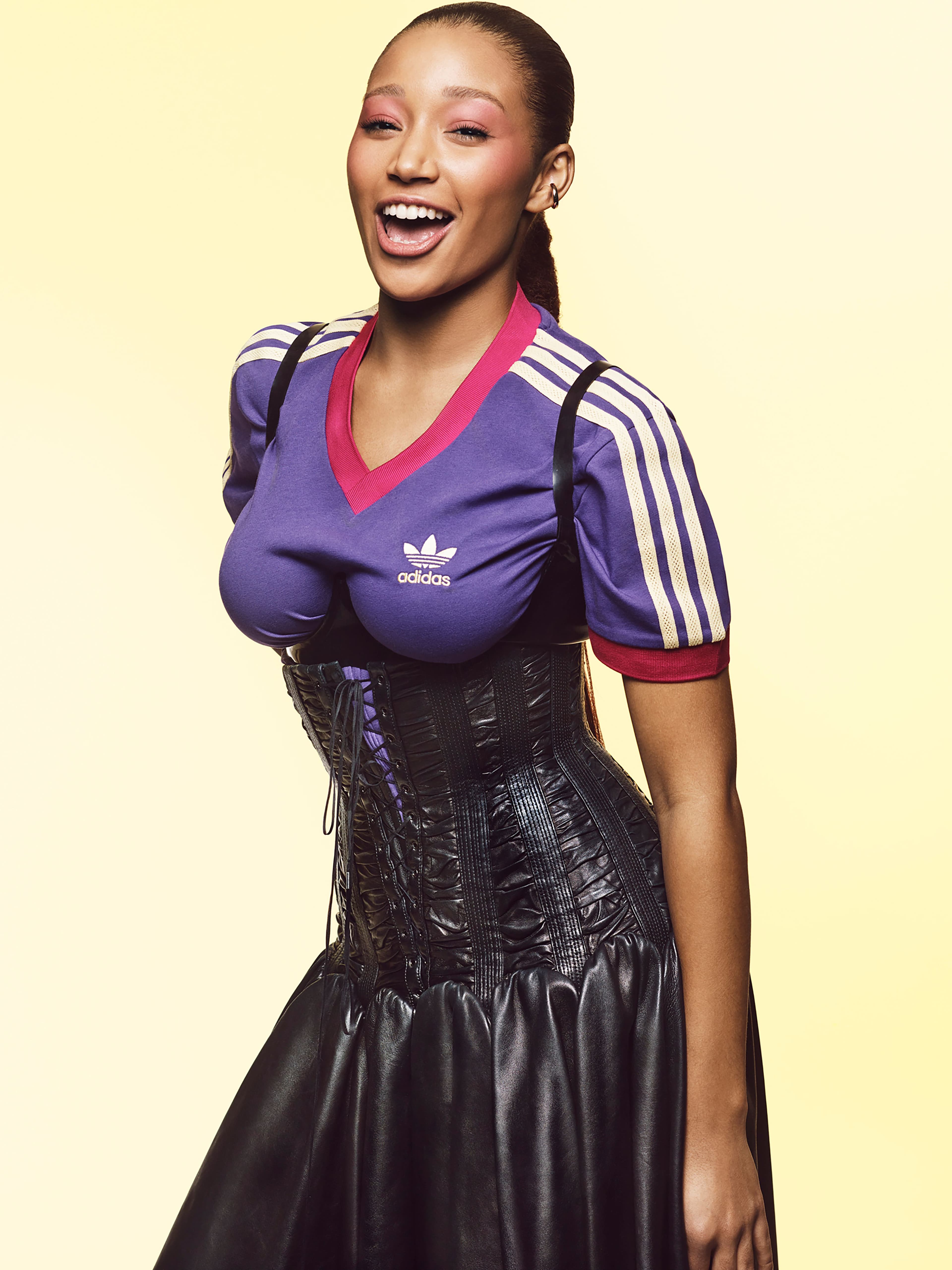
T-shirt by Adidas Originals by Wales Bonner. Dress by Alaïa. Ear cuff by All Blues.

Bra by Alaïa. T-shirt by Dion Lee. Skirt by Sacai. Boots by Paolina Russo x Adidas x Marko Baković. Ear cuffs on right ear by Jennifer Fisher. Ear cuffs on left ear by, from top, All Blues and Jennifer Fisher.
As a nonprofit arts and culture publication dedicated to educating, inspiring, and uplifting creatives, Cero Magazine depends on your donations to create stories like these. Please support our work here.


